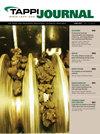全氯过乙酸法制备大麻和杨树纳米纤维素
IF 0.6
4区 农林科学
Q4 MATERIALS SCIENCE, PAPER & WOOD
引用次数: 0
摘要
纳米纤维素是开发先进功能材料的一种有前途和可持续的原料。然而,纳米纤维素的特性,如结晶度、表面能和长径比,可能因生物质来源和预处理方法而异,导致纳米纤维素损失基材料的性能各不相同。本研究采用全氯过乙酸和亚氯酸钠脱木素漂白预处理从大麻和白杨中分离出纤维素纳米晶体,探讨了生物质来源和处理方法对纤维素纳米晶体分离和特性的影响。我们的结果表明,过乙酸处理几乎完全脱木素了大麻和白杨,而亚氯酸钠处理在纸浆中留下了5%-6%的木质素。根据处理方法的不同,生麻和杨树生物量的CNCs产量分别为9.8%-21.9%和10.9%-28.3%。TCF处理的生物质的CNCs的尺寸通常比亚氯酸钠处理的生物质保持更大的宽度和纵横比。杨树来源的CNCs的结晶度略高于大麻来源的CNCs(49%-54%),前者为53%-58%。CNCs的ζ电位范围为-20.1mV至-31.1mV,确保了水溶液的良好分散。CNCs的表面能(分散能为40–80 mJ/m2,比能为2–10 mJ/m2)、水相互作用和热稳定性是可比较的,无论生物质来源和预处理方法如何。我们的发现表明,过乙酸处理的TCF技术是一种很有前途的脱木素和漂白方法,可以从草本和硬木生物质中获得富含纤维素的纸浆,用于分离纳米纤维素。本文章由计算机程序翻译,如有差异,请以英文原文为准。
Totally chlorine-free peracetic acid pulping for nanocellulose isolation from hemp and poplar
Nanocellulose is a promising and sustainable feedstock for developing advanced and functional materials. However, the characteristics of nanocellulose, such as crystallinity, surface energy, and aspect ratio, can vary depending on biomass source and pretreatment methods, leading to variable performance of the nanocellu-lose-based materials.
In this study, cellulose nanocrystals (CNCs) were isolated from hemp and poplar using totally chlorine free (TCF) peracetic acid and sodium chlorite delignification and bleaching pretreatments to probe the influences of biomass source and treatment methods on the isolation and characteristics of CNCs. Our results showed that hemp and poplar were almost completely delignified by peracetic acid treatment, whereas sodium chlorite treatment left 5%–6% lignin in the pulp. The yields of CNCs from raw hemp and poplar biomass ranged from 9.8% to 21.9% and 10.9% to 28.3%, respectively, depending on the treatment methods. The dimensions of CNCs from TCF-treated biomass generally maintained a larger width and aspect ratio than those from sodium chlorite-treated biomass. The poplar-derived CNCs exhibited slightly higher crystallinity of 53%–58% than hemp-derived CNCs of 49%–54%. The zeta potential of the CNCs, ranging from -20.1 mV to -31.1 mV, ensured a well-dispersed aqueous solution. The surface energy (dispersive energy of 40–80 mJ/m2 and specific energy of 2–10 mJ/m2), water interaction, and thermal stability of the CNCs were comparable, regardless of the biomass source and pretreatment methods. Our finding suggests that the TCF technique with peracetic acid treatment is a promising delignification and bleaching approach to obtain cellulose-rich pulps from herbaceous and hardwood biomass for nanocellulose isolation.
求助全文
通过发布文献求助,成功后即可免费获取论文全文。
去求助
来源期刊

Tappi Journal
工程技术-材料科学:纸与木材
CiteScore
1.30
自引率
16.70%
发文量
59
审稿时长
6-12 weeks
期刊介绍:
An internationally recognized technical publication for over 60 years, TAPPI Journal (TJ) publishes the latest and most relevant research on the forest products and related industries. A stringent peer-review process and distinguished editorial board of academic and industry experts set TAPPI Journal apart as a reliable source for impactful basic and applied research and technical reviews.
Available at no charge to TAPPI members, each issue of TAPPI Journal features research in pulp, paper, packaging, tissue, nonwovens, converting, bioenergy, nanotechnology or other innovative cellulosic-based products and technologies. Publishing in TAPPI Journal delivers your research to a global audience of colleagues, peers and employers.
 求助内容:
求助内容: 应助结果提醒方式:
应助结果提醒方式:


